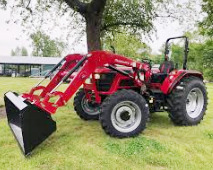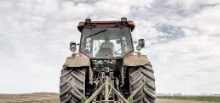________________________________________________________________________________________
| Home / Farm Tractors / Mahindra Tractors / Mahindra 6065 |
Mahindra 6065 Troubleshooting
 The
Mahindra 6065 utility tractor was manufactured between 2018 and 2023. The
Mahindra 6065 driveline consists of four-cycle three-cylinder direct injection
turbocharged intercooled diesel engine and 15x15 power shuttle transmission. A
161.6 cubic inches (2.6 L) engine has a cylinder bore of 3.78" (96 mm), piston
stroke of 4.8" (122 mm), and rated power of 62 Hp (46.2 kW). The maximum forward
speed - 24.8 mph (39.7 km/h), maximum reverse speed - 24 mph (38.4 km/h).
The
Mahindra 6065 utility tractor was manufactured between 2018 and 2023. The
Mahindra 6065 driveline consists of four-cycle three-cylinder direct injection
turbocharged intercooled diesel engine and 15x15 power shuttle transmission. A
161.6 cubic inches (2.6 L) engine has a cylinder bore of 3.78" (96 mm), piston
stroke of 4.8" (122 mm), and rated power of 62 Hp (46.2 kW). The maximum forward
speed - 24.8 mph (39.7 km/h), maximum reverse speed - 24 mph (38.4 km/h).
The open center hydraulic system includes a gear pump with rated fluid flow of 11.1 gpm (42 lpm). The Mahindra 6065 is equipped with a hydrostatic power steering system, hydraulic wet disc brakes, 11.2x24 front tyres, and 16.9x28 (2WD) or 16.9x30 (4WD) rear tyres. The wheelbase is 90" (2280 mm) for 2WD models and 90" (2280 mm) for 4WD models. The tractor is compatible with Mahindra 6075CL front end-loader with a maximum lift height of 133" (3370 mm), and Mahindra 65B backhoe with maximum digging depth of 112" (2840 mm).
| Diesel Engine Troubleshooting |
| Diesel hard to start or doesn't start |
Air in fuel system - Bleed fuel system.
Clogged fuel filter - Clean or replace the filter.
Clogged or burnt injection nozzle - Service or change injection nozzles.
Water in the fuel system - Change fuel and repair fuel system.
Valve clearance is wrong - Check and adjust.
Damaged fuel injection pump - Replace injection pump or repair it.
| Engine starts but stalls suddenly |
Plugged air cleaner - Clean or replace the element.
Fuel filter element is clogged - Replace filter element.
Poor fuel injection pump tightness - Look for any leaks of fuel pump Tighten it fast.
Fuel injectors are faulty or clogged - Test and replace fuel injectors if necessary.
Faulty fuel injection pump - Repair or replace injection pump.
| Engine stalls while running |
Engine has not warmed up to the recommended temperature - Engine is not warmed up to the required temperature.
Fuel filter element is clogged - Filter maintenance required.
Air trapped in fuel system - Bleed air.
Dirty or damaged injection nozzles - Clean or change injection nozzles.
Improper setting of fuel injection pump timing - Set the fuel pump timing correctly.
| Engine stops when idle |
Low idle speed setting is incorrect - Correct low idle adjustment.
Fuel injection pump malfunctioning - Rebuild or change fuel pump.
Dirty or defective injectors - Test and replace fuel injectors if necessary.
Improper valve clearance - Adjust valve clearance.
| Engine power loss |
Air cleaner is dirty - Service air cleaner.
Clogged or defective injection nozzles - Inspect nozzles and replace if necessary.
Incorrect fuel injection pressure - Adjust pressure to proper level.
The valve clearance is incorrect - Correct valve clearance.
Incorrectly set low idle speed - Correct low idle settings.
Restricted fuel lines or hoses - Clean fuel system hoses and lines.
Cylinder-head gasket is broken - Change cylinder head gasket.
Worn or broken piston rings - Install new piston rings.
| Engine overheating |
Insufficient coolant - Add coolant fluid to cooling system and also check it for leaks.
Lack of engine oil - Check oil level and add oil as required.
Defective radiator cap or clogged radiator fins - Replace cap or clean radiator.
Loose or damaged fan belt - Replace the fan belt.
Engine is running overloaded - Reduce load or shift to lower gear.
| Insufficient oil pressure |
Not enough oil in the engine - Need to add oil.
Plugged engine oil filter - Replace or clean engine oil filter element.
Oil grade or viscosity is incorrect - Use correct viscosity oil.
Incorrect crankshaft bearing oil clearance - Change bearings.
Oil pump failure - Inspect and change as required.
| Engine knocks or noises |
Engine oil level is insufficient - Fill up the oil to required level.
Engine not warmed up - Warm up engine as required.
Improper fuel injection timing - Set up as recommended.
Low idle speed setting is not correct - Adjust low idling as recommended.
Defective fuel injectors - Replace fuel injectors.
Connecting rod is defective or misaligned - Connecting rod needs to be replaced or aligned.
Pistons are broken or worn - Have pistons replaced.
| Transmission Troubleshooting |
| Transmission oil pressure is low |
Transmission fluid level is low - Need to add transmission fluid.
Transmission oil filter is dirty (if equipped) - Service or change transmission oil filter.
Relief valve malfunction - Replace relief valve.
| Transmission makes excessive noise |
Lack of transmission oil supply - Need to add transmission oil.
Transmission fluid is dirty - Change the fluid.
Defective gears or improper backlash - Change the gears or set backlash properly.
Worn or damaged bearings - Bearings replacement required.
Worn or bent gear shift forks - Replace the shift forks.
Shaft splines are damaged or worn - Replace defective shaft.
| Hard shifts |
Worn or rusty gear shift linkage - Shift linkage need to be replaced.
Worn or bent shift forks - Install new shift forks.
Defective parts in the gearshift mechanism - Replace defective parts.
Clutch is worn or not adjusted - Clutch adjustment or replacement required.
| Transmission oil leaks |
Transmission fluid level is high - Correct the fluid level.
Damaged seals or gaskets - Gaskets or seal need to be replaced.
| Hydraulic System Troubleshooting |
| Low hydraulic oil pressure |
Hydraulic oil level low - Check and refill the hydraulic oil.
Clogged hydraulic oil filter element - Hydraulic filter maintenance required.
Hydraulic pump is defective - Repair or replace hydraulic oil pump.
Not adjusted hydraulic spool valve - Need to adjust spool valve.
Hydraulic cylinder failure - Change or repair hydraulic cylinder.
Leaks in hydraulic pipes - Inspect the system for leaks and fix it.
| Hydraulic system is too hot |
Faulty main relief valve - Relief valve need to be replaced.
Incorrect hydraulic oil type - Use the correct type of hydraulic oil.
Contaminated hydraulic fluid - Change hydraulic fluid.
There is air in the hydraulic system - Bleed hydraulic system.
| Hitch not raising or hitch raises slowly |
Excessive loading on the hitch - Load needs to be reduced.
Low hydraulic fluid level - Fill the system to proper hydraulic fluid level.
Clogged hydraulic fluid filter - Clean or replace the hydraulic filter.
Faulty hydraulic pump - Repair or replace hydraulic oil pump.
Main relief valve is damaged - Replace relief valve.
Defective hydraulic spool valve block - Repair or change hydraulic valve.
Hydraulic cylinder not working - Replace or repair hydraulic cylinder.
Suction line is disconnected or broken - Replace or connect correctly.
| 3-point hitch does not lower or lowers very slowly |
Incorrect setting hydraulic control valve block - Set correctly.
Hydraulic cylinder not working - Repair or install a new hydraulic cylinder.
3-point hitch is out of adjustment - The three-point hitch must be adjusted.
Lift arm shaft is damaged - Change the shaft.
| Jerky lowering or lifting of the hitch |
Air in hydraulic pipes - Bleed hydraulic pipes.
Hydraulic oil is dirty - Hydraulic oil change required.
Hydraulic pump is faulty - Install a new hydraulic fluid pump.
Faulty hydraulic control valve - Repair or change the valve.
Hydraulic cylinder not working - Change or repair hydraulic cylinder.
| Steering Troubleshooting |
| Steering wheel is hard to turn |
Damaged or incorrectly assembled steering column - Replace steering column or assemble correctly.
Air trapped inside steering system - Need to bleed air.
Not adjusted toe-in - Adjust toe-in wheels.
Uneven wear on front tires - Replace the tires.
Steering pump is faulty - Install a new hydraulic steering pump.
Stuck or damaged steering pump control valve - Replace or clean flow control valve.
Steering oil level is insufficient - Checking steering oil level and add it if necessary.
| Excessive steering wheel free play |
Worn steering column shaft or coupling - Replace defective component.
Steering pump not working - Check the steering pump and replace if necessary.
Worn or loose steering linkage joints - Check and change as required.
| Tractor pulls to right or left |
Tires have uneven wear - Replace the tires.
Not adjusted toe-in - Check and adjust toe-in.
Steering linkage components are loose or worn - Repair or replace steering linkage.
Front wheel bearings are defective or improperly adjusted - Adjust correctly or install new bearings.
| Electrical Troubleshooting |
| Battery won’t charge |
Corroded or loose electrical wire connections - Tighten or clean electrical wiring connections.
Faulty battery terminal clamps - Replace terminal clamps.
Worn-out battery - Install a new battery.
Loose or defective belt - Adjust belt tension or change the belt.
| Starter turns slowly |
Low battery voltage - Recharge the battery.
Battery drains quickly - Service charging system or replace battery.
Bad battery terminals or disconnected wiring - Connect wires properly or change terminals.
| Starter motor won't turn |
Battery is drained or defective - Change or recharge battery.
Battery cables are disconnected or incorrectly connected - Check cables and connect as needed.
Low battery voltage - Charge the battery.
Starter motor failure - Starter needs to be replaced.
________________________________________________________________________________________
________________________________________________________________________________________
| Farm Tractors Technical Specifications |
